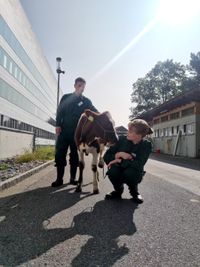Where will you study?
In a faculty that was founded in 1901 and offers the same curriculum as in Zurich. We are about 400 enrolled students here.
In the first year, the lectures are less specific and will only partly take place at the animal hospital. You will be on the road a lot.
The animal hospital consists of several clinics and many other buildings. Below you will find a short overview:
CLINICS
Small animal clinic
The small animal clinic consists mainly of two departments: surgery and internal medicine.
Surgery (orthopedics, stomatology) is responsible for surgical interventions, treatment of accident patients and therapies of musculoskeletal diseases.
Internal medicine takes care of diagnosis and treatment of infections, immune diseases, tumors and endocrinological problems. Diagnosis is determined by blood, urine and fecal analysis or X-rays, ultrasound examinations, MRI and CT. In addition, tissue samples are taken for cytological and histopathological examination.
There are also various ongoing research projects at the Small Animal Clinic.
Equine clinic
The equine clinic is also divided into the departments of surgery and internal medicine.
Surgery deals mainly with lameness surgery and diagnosis, including related therapies.
Internal medicine includes patients with colic (before they need surgery) and animals with metabolic disorders or kidney and lung problems.
Ruminant clinic
Cattle, sheep, goats and new world camelids such as llamas and alpacas are cared for here. The cattle are kept tethered or in individual free-range stalls, and they are allowed to roam on small pastures or in sandy runs. In addition, isolation stalls are available in the event of the emergence of transmissible infectious diseases.
In this clinic, research is conducted on udder health, hollow organ motor function and castration.
Swine Clinic
The pig clinic has individual boxes for inpatients, which are mainly used for diagnostics in herd medicine. A single animal is selected and treated in the animal hospital in order to then treat the rest of the herd properly at home. The pig clinic is affiliated with the ruminant clinic.
PRECLINICAL DEPARTMENT
Genetics
Genome analysis of domestic animals, molecular genetic research projects on hereditary skin diseases and developmental skin disorders, color inheritance, fertility, etc.
Veterinary anatomy
Light and electron microscopy, research on sperm maturation, voltage-gated sodium channels, validation of recombinant vaccines, mycoplasma pathogenicity, bone remodeling in dogs, etc.
Veterinary Pharmacology & Toxicology
Research in the field of ion channels and serotonin receptor subtypes in the gastrointestinal tract.
Beginning with the second year course, basic pharmacology and toxicology are taught, and associated pharmacology is looked at with each organ block.
Veterinary Physiology
Conducts research primarily on lactation in cows, nutrition, metabolism, and gastrointestinal diseases in all domestic animals.
DEPARTMENT PARACLINIC
Veterinary Pathology
This institute teaches students the basics of general pathology in the second year, plus organ-specific features in each block. In the fourth year, theory on specific pathologies follows. In the fifth year, the students help out in the individual clinics and learn the practical application.
As a service, the institute provides diagnoses including dissections and biopsies of both pets and domestic animals as well as exotics, wild animals and fish.
Fish and wildlife medicine
Fish and wildlife medicine is covered for one week in the fourth year. The department studies the health status of free-living and human-cared fish and wildlife, including zoo animals. The goal of the work is to understand the interactions between disease incidence and environmental factors.
Parasitology
Parasitology classes are divided between the 2nd and 3rd years of study. During these two years, the most clinically important and relevant parasites are looked at. A refresher is then given in the 4th year. The Institute of Parasitology offers a wide range of diagnostics including human medicine. Research is conducted on the fox tapeworm (Echinococcus), Neospora, Babesia, Trichnella and more.
Molecular pathology
Here, the focus is on the molecular and cell biological aspects of the interaction between pathogen and host.
Veterinary Bacteriology
The first part of the lectures covers the general principles of bacteriology, before moving on to specific pathogens in the second part. The institute offers many diagnostic procedures and is responsible for monitoring bacterial animal diseases.
Veterinary virology
The basics for this subject are taught in the 3rd year. In the 4th year, the clinical aspects and applications are added. Research focuses on the pathogenesis and virus evolution of lentivirus and pestivirus infections in cattle, sheep and goats.
Immunology
The Immunology Department helps other institutes and departments to create and adapt new tests. The research is mainly concerned with the pathophysiology of macrophages. The basics of immunology are taught in the 2nd year, plus individual aspects within the organ-centered blocks.

